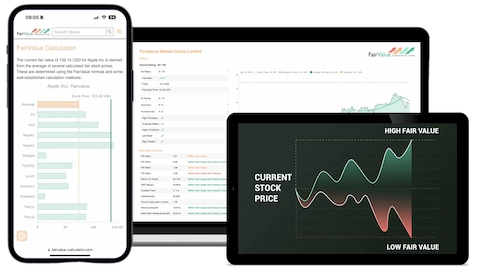Super Fair Value Calculator
AI Generated Formula to Value Stocks
🌟 Super Fair Value Calculator
The Super Fair Value v4 blends balance-sheet strength with a smoothed growth function (sigmoid) to avoid runaway values. Enter figures in millions for assets and shares; growth in percent.
Inputs are **millions** for assets and shares; growth in % (negatives allowed). The sigmoid smooths extremes so high growth doesn’t explode valuations.
Get Even More Value!
- Try Premium for Free
- Instantly discover the Peter Lynch Fair Value for over 45,000 stocks – fully automated, zero effort.
- The Pro Tool for serious investors: Automated stock analysis using 10+ valuation models, including the Peter Lynch Fair Value.
- A powerful algorithm combines AI and over ten valuation models to calculate an average Fair Value – based on DCF, Buffett, Graham, PEG ratio, Peter Lynch, multiples, P/B, P/S and more!
Top 10 Stocks: AI Selection Strategy
This list is updated daily by our Stock Screener Tool, covering more than 60,000 stocks worldwide. Discover this and many other Top-Lists inside the Fairvalue Calculator Premium Tool – try it now for free!
AI Super Fair Value Project
The Super Fair Value Calculator is more than just a stock valuation tool – it is a cutting-edge AI Fair Value project that combines financial data, machine learning and evidence-based research into one intelligent platform. Traditional valuation methods like P/E, P/B, or DCF models often leave investors struggling with inconsistent results, but our AI-driven system smooths out market noise and delivers a clear, objective view of what a stock is really worth.
By blending balance sheet strength, historical mean reversion and mathematically optimized growth expectations, the Super Fair Value Calculator creates a robust framework for AI-powered valuation analysis. Unlike static models, it continuously adapts to new data, offering users a dynamic fair value estimate that reflects both fundamentals and realistic growth. This makes it an ideal solution for investors who want to cut through speculation and focus on evidence-based decision making.
The goal of this AI Fair Value engine is not only accuracy but also accessibility. With just a few clicks, investors can analyze any stock worldwide, compare fair value to current price, and make informed choices without hours of manual Excel work. The calculator transforms professional-grade analysis into a user-friendly experience, empowering retail investors and professionals alike.
As an AI project, the Super Fair Value Calculator goes beyond automation – it integrates human financial expertise with the efficiency of machine intelligence. It stands as a unique example of how AI in finance can increase transparency, reduce bias, and give investors more confidence in their strategies.
For anyone searching for a reliable AI Fair Value Calculator, this tool offers a modern, science-backed approach that combines the best of traditional investing principles with next-generation AI innovation.

💬 Comment by Dr. Peter Klein, Founder of Fairvalue Calculator:
Developing the Super Fair Value Calculator has been one of the most exciting projects for me — because it is actually AI-driven from the ground up. Artificial intelligence suggested which financial ratios to use, how to combine them into formulas, and even which scientific studies and statistical evaluations should form the backbone of the model.
My role was to take this raw AI output and shape it into a tool that is transparent, reliable and truly useful for investors. The result is a calculator that blends balance sheet strength with smoothed growth expectations, giving you a realistic fair value for any stock — not as a guess, but grounded in data and evidence.
What fascinates me most is how AI and investing can complement each other: while AI handles the complex formulas and statistical work, I focus on making the results understandable and practical. Together, this creates a fair value tool that is both smart and approachable.
👉 Try the Super Fair Value Calculator and see how AI changes valuation.
FAQ: Super Fair Value Calculator
One overview that combines several valuation methods into a clean fair-value range you can act on with a clear Margin of Safety.
What does the Super Fair Value Calculator do? ▾
Which valuation methods are combined here? ▾
- Discounted Cash Flow (DCF)
- Dividend Discount Model (DDM)
- Classic heuristics: Graham-Dodd, Graham Number, Peter Lynch PEG, Buffett-style.
- Cross-checks with EV-based multiples on Stock Valuation.
How should I interpret the blended value and range? ▾
Which inputs drive results across methods the most? ▾
- Growth and margin trajectory.
- Reinvestment needs (CapEx and working capital).
- Discount rate or WACC and terminal value.
- Share count and potential dilution.
How do I keep capital structure and EV consistent? ▾
How do I handle cyclicality and one-off items across methods? ▾
When should I rely more on one method than another? ▾
- DCF: broad applicability, best for cash-flow visibility.
- DDM: stable dividend payers with predictable payouts.
- Heuristics: quick screens; always cross-check with cash flows and EV multiples.
How should I set scenarios and sensitivity tests? ▾
- Base: mid-cycle growth and margins.
- Bear: lower growth, lower margins, higher discount rate.
- Bull: prudent upside on growth or efficiency.
How do I turn the output into a buy, hold or sell? ▾
Common mistakes to avoid with blended valuation ▾
- Mixing TTM with forward inputs inconsistently.
- Ignoring EV reconciliation when comparing multiples.
- Over-weighting heuristic outputs for cyclicals or negative EPS.
What’s a practical workflow around this page? ▾
- Screen: Build a list in the Stock Screener.
- Value: Use this Super page to triangulate; model details in the DCF Calculator.
- EV: Compute clean EV and compare multiples on Stock Valuation.
- Allocate: Manage diversification and cash quota in the Portfolio Manager.


